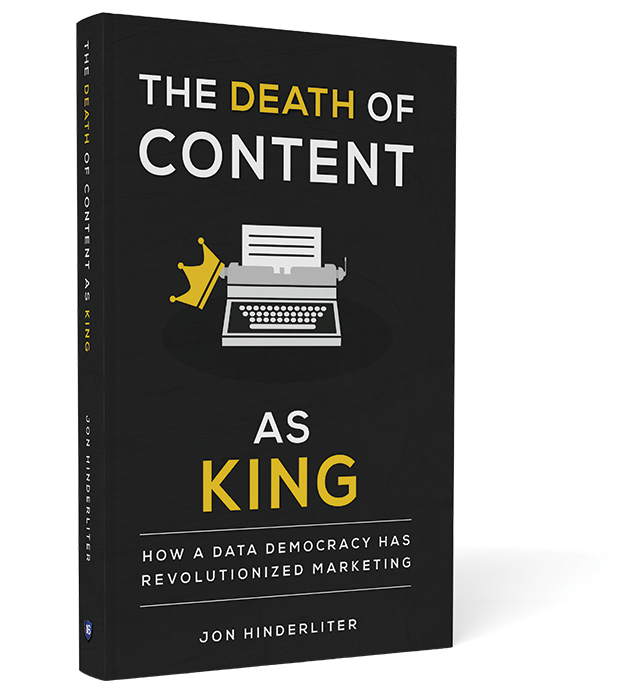
By Tim Sweeney
Jon Hinderliter’s new book, The Death of Content as King, examines what he says is a once-in-a-generation shift toward a reliance on data that marketers need to fully recognize.
I f you are a marketer or creative who pursued your profession because you wanted nothing to do with statistics and survey results, the title of Jon Hinderliter’s new book, The Death of Content as King: How a Data Democracy Has Revolutionized Marketing, might not be an enticing choice for your next beach read. But don’t be scared off by the notion of spreadsheets ruining your life. Hinderliter himself says that his book is not about forcing people to fall in love with data, but rather about encouraging them to understand the dominant role it now plays.
“It’s less about stopping content creation and more about knowing what works,” Hinderliter says. “Without data, the marketer risks the chance of missing the consumer and, even worse, not knowing they missed them. Organizations of any size should start by looking at the data around points of awareness, purchase, and experience.”
One of Hinderliter’s main points in the book is that only data can determine the who, what, where, when, and why for content. Content itself cannot tell you about the audience who views, reads, or listens to it; what part of it was consumed by that audience; where the audience was before or after consuming it; when it was consumed; or, most importantly, why the audience cares about it.
“The content on the web page as text, audio, or video can’t answer any of these questions,” Hinderliter writes. “Its only purpose and function is to be consumed. Only data can provide value from the content.”
But cheer up, content creators
That means the data you consume should be helping you spend your creative and writing time more efficiently and helping make the work you produce more effective.
”Data is the vote and voice of the consumer and data must drive content creation and marketing efforts.
Data takes the dominant role
Before taking his current position as the Director of Marketing and Communications for University College at Washington University in St. Louis, Hinderliter spent over fifteen years in data-driven marketing jobs. It was an experience earlier in his career, when he was working as a marketing coordinator in the casino industry, that opened his eyes to the idea that “data is the vote and voice of the consumer” and data must drive content creation and marketing efforts. But first, he says, marketers need to come to grips with the idea that a paradigm shift toward data has occurred in the marketing world.
As new platforms have emerged in the era of the internet, the dominance has moved to data as it plays a larger role in both marketing and the consumer experience. He points out that “the three most dominant platforms in search (Google), social (Facebook), and e-commerce (Amazon) achieved their lofty status by finding value in the data versus the content.” All of these major platforms use data exclusively to personalize the user experience. “Algorithms are now creating unique search results, social news feeds, and e-commerce offerings where content is just another data point for them,” Hinderliter says.
So, if you are that creative type who abhors data, should you be readying yourself to become intimately acquainted with Excel files, counting clicks on social media, or scrolling through surveys to better understand your audience? Hinderliter says it will be all of the above, and with the amount of data collected now growing faster than the internet itself, sifting through that data to find what is useful is a daunting thought.
“Quantitative and qualitative measurements are critical to understanding audience preferences, and that will come from a variety of sources and methods,” he says. “But the most crucial part is knowing what data to measure.” And for many, the problem isn’t whether or not you have data; you probably have more than you know what to do with. More often than not, the problem is knowing which data is important and how to use the data to improve the way you engage with your consumers.
The VOTE data framework
To help marketers, Hinderliter presents what he calls his VOTE data framework model, which allows marketers to take into consideration whether the data they are collecting is valuable, organizable, targetable, and explainable.
- VALUABLE data is anything meaningful and relevant to an organization’s goals. Data in this category is most significant when it can be connected between the consumer and the product or service.
- ORGANIZABLE data has the most criteria in the model, as it is data that can be collected, stored, sorted, and repeated.
- TARGETABLE data should be data points used for directly aiming at or indirectly knowing that for which consumers aim. The intent is to remove any doubts for marketers about what data is needed or required by this model.
- EXPLAINABLE data must be understood by stakeholders both inside and outside of marketing. In every organizational hierarchy, marketing is accountable to others higher up in leadership, and those higher-ups need to understand why the data is useful to marketing.
“The VOTE data framework model is designed to be universal and flexible enough for any size [of] organization and can be designed to be unique to each user. It’s not just about what you include but also what you exclude,” says Hinderliter. A relevant example he shares is his own experience in higher-education marketing and taking a data-driven approach to campus tours.
“We started by looking at the enrollment process and anywhere a student could discover an aha moment of their own throughout that process. We found a significant connection with campus tours. It ranked sixth as a valuable experience
or enrolled students at the university and fifth in a nationwide survey of factors that influenced college selection. It was undeniably a valuable data point that connected the student candidate to actual enrollment,” explains Hinderliter.
From there, Hinderliter could organize the information from the campus-tour-registration web page and compare it with their CRM and the university’s admission applications. They could see the connections between a campus tour and enrollment, as well as a problem—an 86 percent form-abandonment rate on the website.
The team discovered what was targetable data by removing many of the fields present on the form, leaving only the data collection points that Admissions could use for the campus visit and would thus make for a better onboarding experience.
Because Hinderliter and his team had taken the steps to determine if the campus-tour data was valuable and had organized the data against other sources, they were able to target students from the initial visit to the campus-tour web page. They now met the criteria for explainable data sets for leadership to sign off on a proposed project to redesign and improve the campus-tour web registration experience. The result was the largest increase in campus-tour attendance in school history.
Once you have your useful data, how can you put it to work and apply your creative to what you’ve learned? For starters, consider the full journey of your consumer, not just where you want him or her to go in the end. In his book, Hinderliter showcases The Modern Consumer Decision-Making Journey by Mark Michael, which discusses 14 stages that the consumer experiences and explains where marketers can adjust the creative messages at every stage by relying on the data gathered.
“We can see this already in the differences between creative designed for brand awareness efforts and messages designed within CRM communication plans,” Hinderliter says. Consumers don’t just trip and fall on the Buy Now button. Studies show that the more often consumers are exposed to a brand’s marketing message, the more likely they are to consider it. Now, imagine if that message never changes, always looks the same, and is always in the same location or channel. It becomes invisible to the consumer as they mentally begin to ignore it.
On the other hand, a data-driven approach would respect the consumer’s journey and adjust accordingly, making the message more effective, more persuasive, and harder to ignore. Hinderliter points to Netflix and sports-apparel maker Fanatics as companies that have found ways to achieve data-driven experiences while personalizing the journey to connect with the consumer. He highlights instances where these brands have used data to both create content and react in real time to consumer intent. Remember, though, that dynamic content doesn’t simply mean a “Hi, (first name here)”-style personalization. It means using different data points to determine which content elements to display for the consumer in a single message. “To be a data-driven experience it has to use strategic techniques like association, visitation, connection, recommendation, and location,” Hinderliter says.
He points to Experian’s Mosaic household-based consumer-lifestyle segmentation as a prime example of association. Mosaic classifies more than 126 million households in the United States along with 71 unique segments within 19 groups. When it comes to visitation, Optimizely has things dialed in. A provider of personalization technology for websites, Optimizely created 26 different versions of its home page. Each one was uniquely customized for a different segment, for its named accounts that were current or prospective customers by industry visitors, such as travel.
It’s one thing to rely on data to deliver the right message at the right time to your intended target audience. It’s quite another to use this data you’ve acquired to create a new product. That’s what Netflix has done, and Hinderliter says this type of action is the Holy Grail or eureka moment of data-driven experiences.
“This is the future, platforms using data to improve itself for the user,” he explains. “Brands like Netflix have moved in this direction, using data points from their users’ viewing habits to know what type of content to create and what kind of content users will watch next.”
Before you get too carried away thinking data should rule every single decision you make, Hinderliter cautions that he is not advocating for brands to make decisions based on social media metrics such as likes, hearts, shares, or comments.
“Likes, shares, and comments are 100 percent vanity metrics because no organization can exchange those metrics for money,” he says. “That is part of the trap we fell into as marketers, always trying to go viral to reach new audiences, instead of focusing on what converts.”
Algorithms on social platforms constantly change and often reward users with exposure when they use the newest tools, so it’s important to remember that social platforms such as Instagram build new features such as Stories or Reels not for organizations, but for their users. “We know that, by design, major platforms limit the reach of organic content from organizations in favor of user-generated content,” Hinderliter explains. “This is another reason why it’s important for organizations to build their own data-driven experiences that are not reliant on other platforms for reaching consumers.”
For marketing leaders, the increased importance of data will require making difficult choices about how their modern marketing organizations are structured. Hinderliter believes that, in the same way computer skills became crucial to organizational success in the latter part of the last century, analytical skills to deal with large and complex data sets will become must-haves in the marketing field over the next decade.
“Every organization is restricted by two constants which are universal—time and resources,” he points out. “Neither is unlimited. Therefore, priorities must be established to focus on what is going to convert the audience to a consumer of the product or service. It allows organizations to understand what activity produces better results.”
All this use of data begs the question of how people feel about brands knowing exactly what they want to see and when they want to see it. After all, who among us hasn’t been a little freaked out by a targeted Facebook ad that seems to relate to a conversation we’ve just had with a friend? Hinderliter admits that privacy is the greatest challenge to the personalized data-driven experience. In The Death of Content as King, he writes about privacy missteps from brands such as Target and Facebook as well as some strategies to mitigate those risks. He also outlines a number of ways that organizations of various sizes can use data without scaring people. Consumer trust, he says, varies from person to person across different cultures, and what scares away some people will help others or go completely unnoticed elsewhere.
“We are already seeing a more concentrated backlash against data collection by governments, like the European Union’s General Data Protection Regulation (GDPR) and the California Consumer Privacy Act,” Hinderliter says. “While at the same time platforms like Apple iOS and Google Chrome are moving to block third-party tracking by default. In the end, this will only make unprepared organizations more reliant on the major platforms, compared to the well-prepared organizations that have already built a treasure trove of first-party data.”
Hinderliter doesn’t see a winner to be crowned king in the battle between content and data. He sees a healthy working relationship. The content that speaks to the needs and wants of our audiences will be informed by the voice and vote of the consumer, which will be informed by data.
“Creative will always be important because people can’t read ones and zeros,” Hinderliter says. “The balance is about understanding the strengths and weaknesses of each. This can’t be done if the content is always considered king in the relationship.
See how SmartQ™ can work for you.
Download the free whitepaper.







